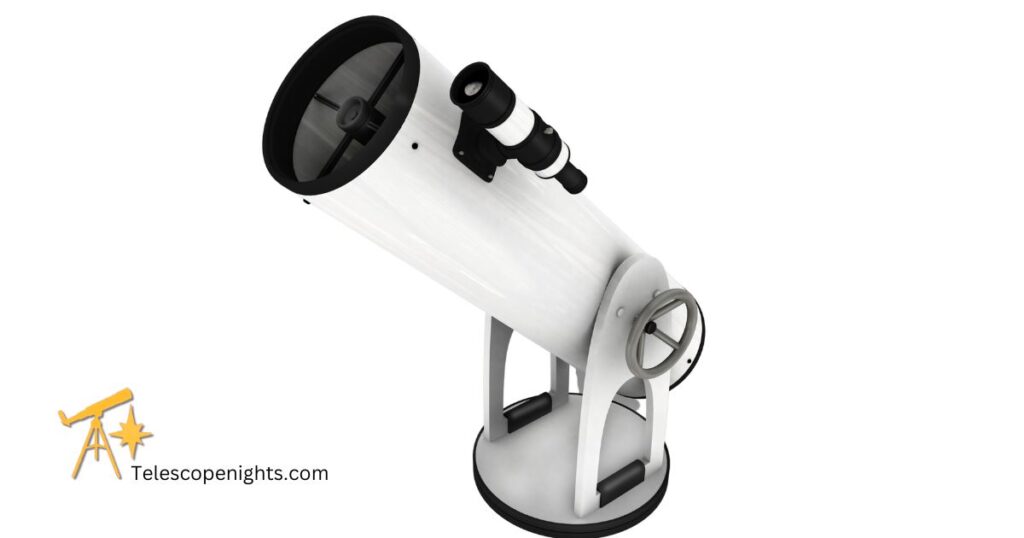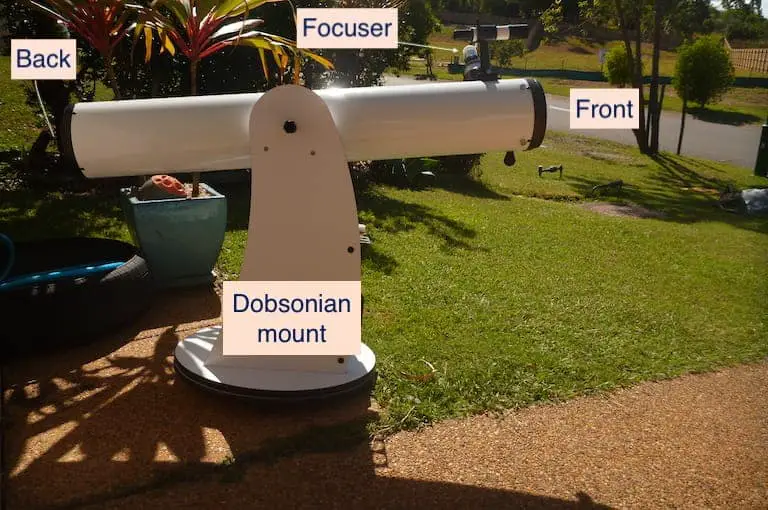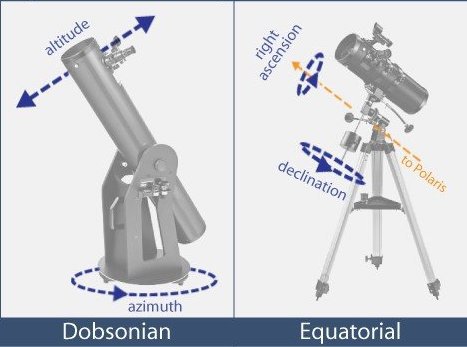A Dobsonian is different from other telescopes for astronomy. The ‘Dobs’ are often recommended for beginners. Here are the Dobsonian pros and cons that you should know before you buy.

If you’re looking to buy a Dobsonian or have already bought one, you’ll benefit from knowing more about this reflector type telescope so you can get the best experience in using it.
The advantages and disadvantages of owning a Dobsonian telescope
Dobsonian telescope: benefits and drawbacks
Benefits
- Simple to use
- Price – Far cheaper than another of the same size
- No need to spend time on polar alignment
- Great for beginners and all ages
- Stable – compared to tripods that tend to shake when touched
Drawbacks
- Not ideal for astrophotography
- Will need collimation at some point — you can get an accessory for this
- Not lightweight, tend to be bulky. The 6-inch (vs. the 8-inch) telescope is easier to handle
- Not compact unless you opt for collapsable models
Understanding the telescope’s pros and cons helps with buying one or not. If you already own a Dobsonian, you’ll get the satisfaction (or not) of knowing you bought a great instrument.
What’s a Dobsonian?
The name, Dobsonian, arises from its designer, John Dobson, who devised the Dobsonian reflector telescope back in the 1960s. It first became popular in the 1970s in northern California.
Its ease of use helped the popularity of the Dobsonian reflector.
How do Dobsonians work?
A Dobsonian, like all reflectors, uses mirrors (vs refractors which use lenses) to capture and reflect light for your night-sky view.
They are simply constructed. The Dobsonian mount is a basic altitude-azimuth, but usually with Teflon bearings, that allows smooth movement in two directions — up and down and side to side (parallel with the horizon). See the diagram in my article explaining the different telescope mounts.

Why are Dobsonian telescopes good?
If you ask a Dob user, they’ll say Dobsonians are good because they’re less frustrating to use than others. Dobs are a bulkier scope but are easy to take out and set up. They are also easy to use and more stable than those mounted on tripods (which tend to shake when touched).
The big advantage and the main reason most beginners opt for a Dobsonian is the price. But don’t confuse this with cheap!
Dobsonians have a simple design of a tube, a set of optics, and a basic mount and it’s this design that makes them more economical than other types of telescopes offering the same aperture size and power.
To further understand this…they use mirrors, which cost less than lenses, the optics used in refractors and Schmidt-Cassegrain telescopes, and so the Dobsonians can be made more cost-effectively than other types of telescopes.
The bigger the aperture, the more it gathers light, right? The more light-gathering ability the more you will be able to observe the fainter details. You can buy a good-sized aperture in a Dobsonian for less than you would any other telescope type.
This is what is meant by Dobsonians giving you “the best bang for the buck”.
Simple fabrication means it not only more affordable but is also quick to set up and use.
No polar alignment needed: There’s no messing around setting the latitude of the mount so the azimuth axis points to the celestial pole.
Stable solid mount: The rocker style alt-az mount is a solid stable construction as well as a simple design. You can use it without concern of breaking cogs or other finer parts.
Dobsonian cons
From time to time, Dobsonians require collimation, which is the process of aligning the mirrors so that they work together to deliver well-focused light to your eyepiece.
You can get collimating tools such as a laser collimator or a collimating eyepiece.
It may seem daunting, but once you get the hang of it, collimating your telescope is not that difficult.
See also: How to collimate a Dobsonian
Dobsonians aren’t lightweight (but are transportable). You might take two trips from your vehicle to set it up in place and will need to consider where you intend to store it.
Because a typical Dobsonian is not computerized (a GoTo), you will need to figure out where to point it to see the object you’re interested in seeing in the sky. Finding the moon is not so much an issue, or the planets usually. But locating those not-so-obvious objects will require maps and some learning of the night sky. Check out our tips on using sky maps/star charts for beginners.
Dobsonians are not useful for taking photos of night sky objects. But the positive of this is that (provided you’re not wanting to take photos) with a Dobsonian…there’s no need to spend all that time having to align the mount with the celestial north or south pole (depending on which part of the world you are observing from).
Dobsonian Pros and Cons vs Newtonian telescope
The obvious difference between Dobsonian and Newtonian telescopes is the mount. In appearance one looks like a cannon base whereas the other is seated upon a tripod.
Dobsonian Telescope
- A type of reflector telescope that uses a basic alt-azimuth mount
- Known for its large aperture, which allows for brighter and clearer images
- Generally more affordable than other types of telescopes with similar apertures
- Easy to use and set up, making it popular among beginners
- Typically used for deep-sky viewing, but can also be used for planetary viewing with the right accessories
Newtonian Telescope
- A type of reflector telescope that uses a parabolic primary mirror and a flat secondary mirror
- Often mounted on an equatorial mount, which allows for easier tracking of celestial objects
- Generally more expensive than Dobsonian telescopes with similar apertures
- Can be more complex to set up and use, but provides more precise viewing once properly aligned
- Can be used for both deep-sky and planetary viewing, depending on the aperture size and accessories
Both of these are reflector telescopes. The Dobsonian mount is very basic and generally made of wood. It is a rocker box alt-azimuth style (left), which compares to the equatorial mount of Newtonians.
If you are into astrophotography, the Dobsonian mount is a disadvantage. A big difference if you are into astrophotography is the mount on the Dob does not allow you to follow the celestial object in the sky as the Earth rotates. This is because the alt-azimuth mount requires manual adjustment with the two axes requiring different rates of rotation.

Both have mirrors, not lenses. They have a primary parabolic mirror and a flat secondary mirror in an open-ended tube with a focuser for an eyepiece on the side. The telescope tube of a Dobsonian is like all Newtonian reflectors.
Plus the optical assembly of both is much the same, where light enters the tube and is picked up by the primary mirror (objective lens), which reflects it on so that the light is concentrated onto the smaller secondary mirror (which is flat) and then finally into the eyepiece.
Dobsonian vs refractor
With the refractor vs Dobsonian telescope, the key thing is we are comparing apples with oranges in regard to their means of light-gathering.
Dobsonian Pros and Cons
- Uses mirrors for light gathering
- Large aperture for brighter and clearer images
- Simple design for easy use and maintenance
- Low cost compared to other telescopes with similar aperture
- Sturdy and stable mount for smooth tracking
- Bulky and heavy design, making it less portable
- No motorized tracking, making it difficult to track celestial objects for extended periods
- Best for viewing deep-sky objects such as galaxies and nebulae
- Requires manual adjustment to track celestial objects
Standard Refractor Pros and Cons
- Involves lenses for light gathering
- More complex design
- More expensive compared to Dobsonian telescopes with similar aperture
- Lightweight and portable design
- Motorized tracking available for extended tracking of celestial objects
- Best for viewing planets and the moon
- Automatically tracks celestial objects for extended periods
How to set up a Dobsonian
Here’s a video look at the size and setup of an 8-inch Dobsonian…
What is the best Dobsonian for beginners?
Amateur astronomers rate the likes of the Orion SkyQuest 6-inch as a good starting point for beginner astronomers wanting ‘the best bang for the buck’. Other brands include Saxon, Skywatcher, and Meade.
It’s an economical buy. And, a 6-inch aperture in a Dobsonian means you should get useful views of the moon and planets. A focal length of 1200mm and aperture of 6″ are good for planet viewing.
Look for one with a focuser made of metal rather than plastic.
…you can look on Amazon:

SkyQuest Classic — See it at Amazon (affiliate link)
The 6-inch gathers a fair amount of light, and so you’d benefit from getting a moon filter.
Also, an extra eyepiece and a Barlow lens should cover you for all magnifications; just make sure your magnifications work out to be within the maximum magnification limits of the telescope. (I include a quick reference for calculating magnifications in my article on buying extra eyepieces.)
For greater comfort, a right-angle finderscope is another option to consider adding when buying your Dobsonian. Or, another option is a Telrad device. This is a finderscope that projects a bulls-eye pattern onto the sky.
The benefit of using a Telrad is that you do not have to awkwardly place your eye up close to the finder as the bulls-eye pattern is visible from distances up to a foot or so behind the device.
I’ve recommended the 6″ here for beginners because the 8-inch and 10-inch ones are heavier and take a bit to move and store.
They aren’t that expensive.
FAQs
Are Dobsonian Telescopes Good For Astrophotography?
They are okay for simple moon shots, but the general answer is no, Dobsonians are not ideal for astrophotography because their alt-azimuth type of mount means you can’t track the object you’re wishing to shoot as it moves in the sky with the rotation of the Earth.
Info resources
NASA Nightsky on choosing a first telescope | Springer Link: John Dobson and His Revolution | Virginia Tech, Dept of Physics: Thinking of Buying a Telescope
